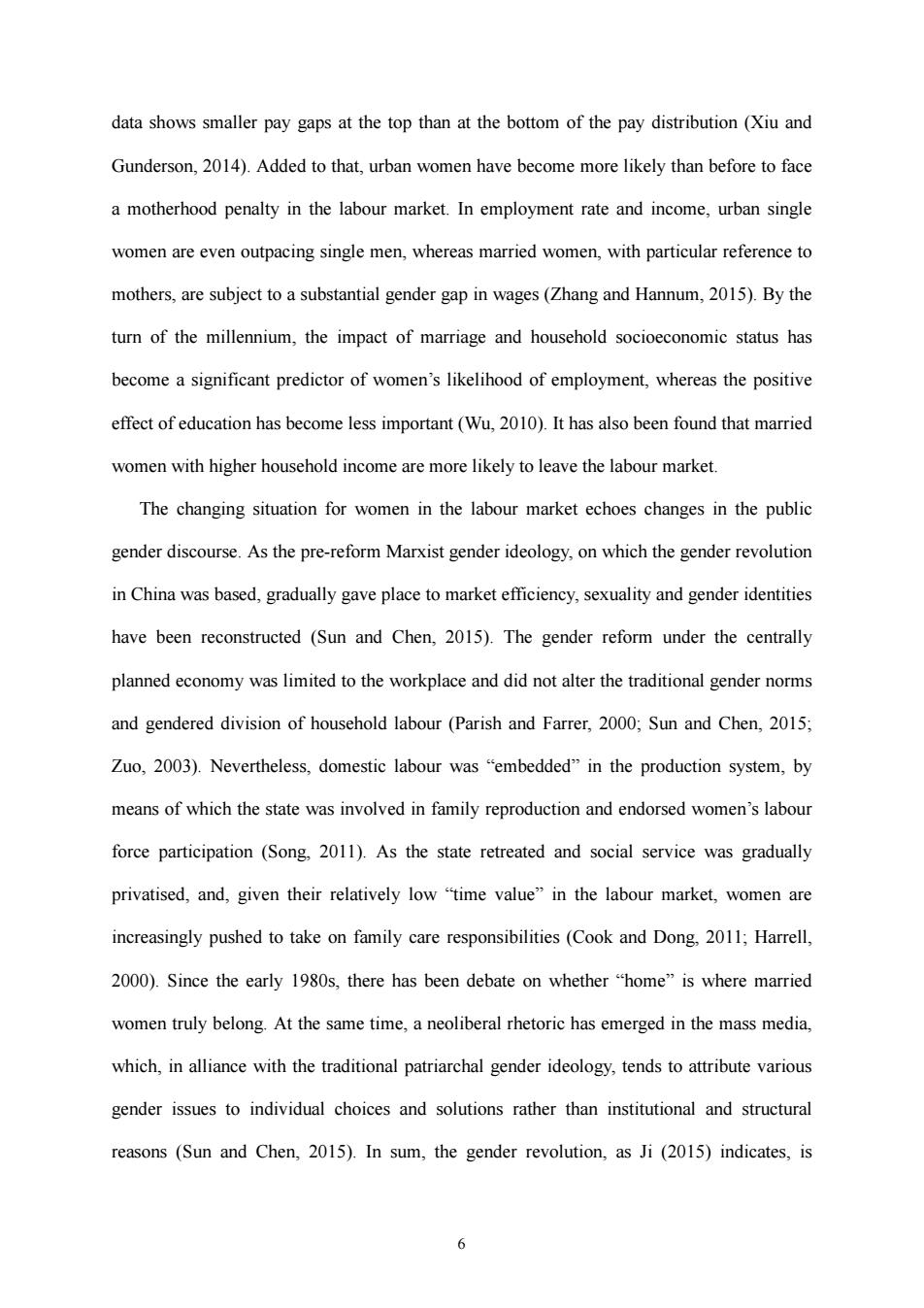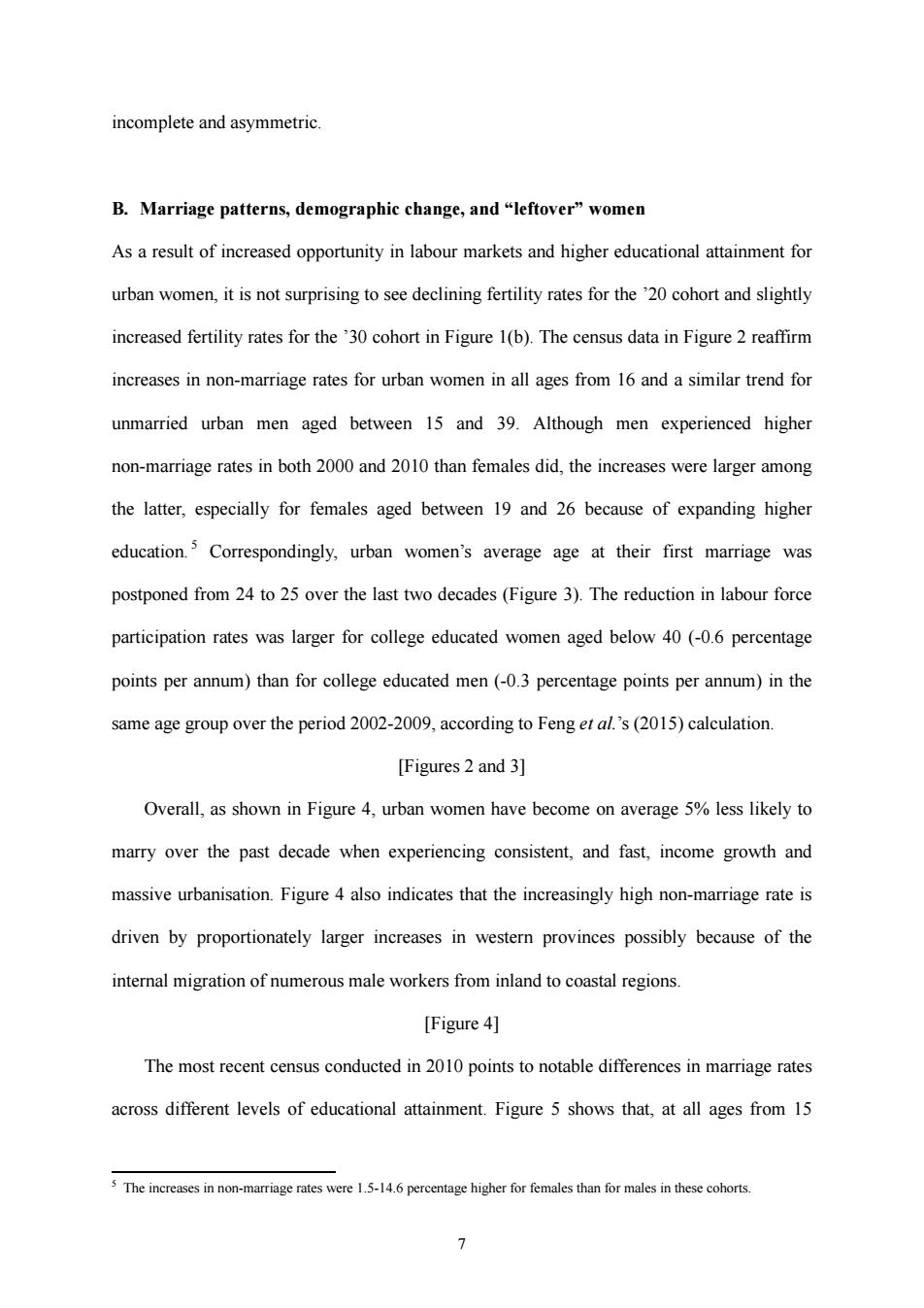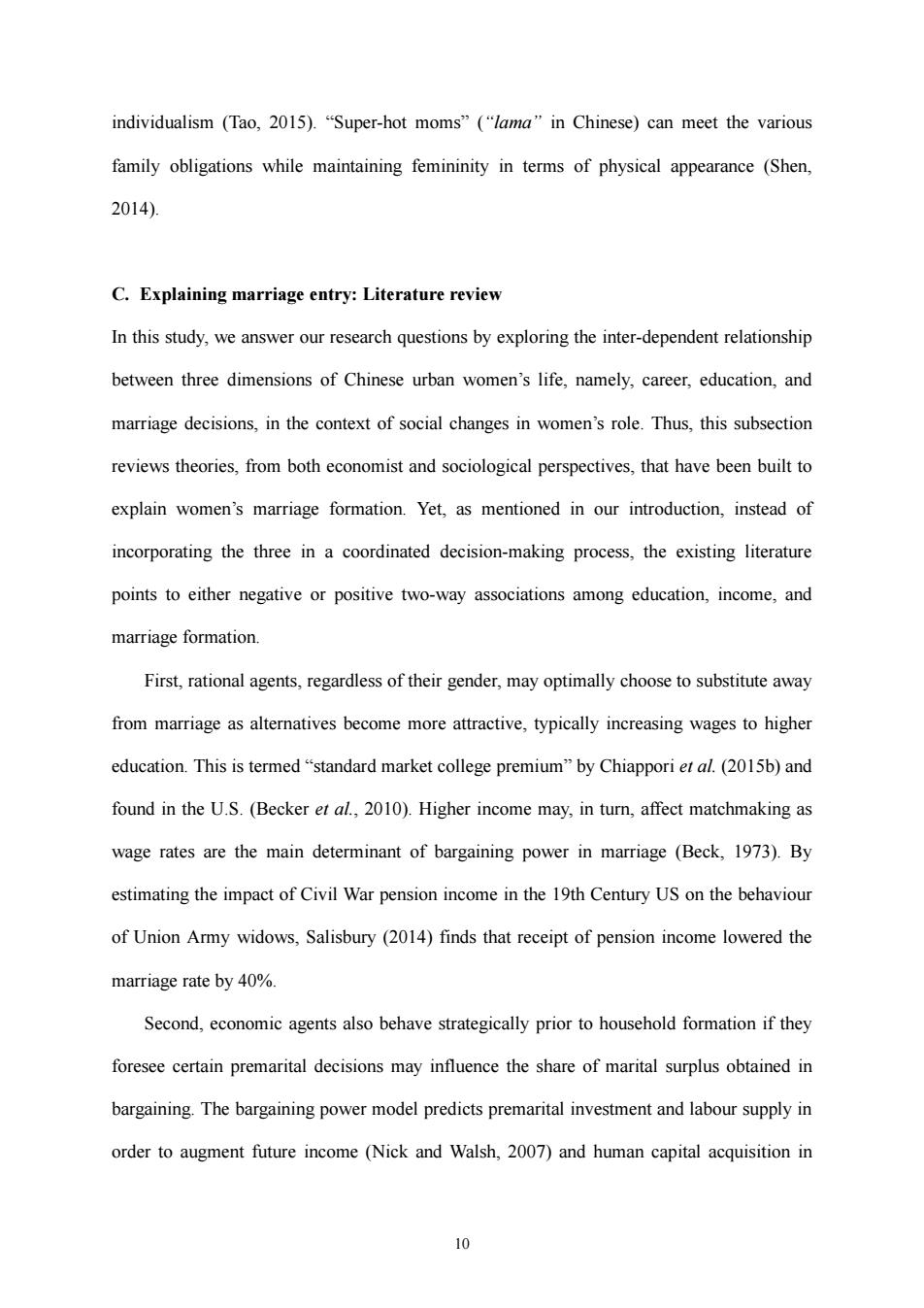
data shows smaller pay gaps at the top than at the bottom of the pay distribution (Xiu and Gunderson,2014).Added to that,urban women have become more likely than before to face a motherhood penalty in the labour market.In employment rate and income,urban single women are even outpacing single men,whereas married women,with particular reference to mothers,are subject to a substantial gender gap in wages(Zhang and Hannum,2015).By the turn of the millennium,the impact of marriage and household socioeconomic status has become a significant predictor of women's likelihood of employment,whereas the positive effect of education has become less important(Wu,2010).It has also been found that married women with higher household income are more likely to leave the labour market. The changing situation for women in the labour market echoes changes in the public gender discourse.As the pre-reform Marxist gender ideology,on which the gender revolution in China was based,gradually gave place to market efficiency,sexuality and gender identities have been reconstructed (Sun and Chen,2015).The gender reform under the centrally planned economy was limited to the workplace and did not alter the traditional gender norms and gendered division of household labour(Parish and Farrer,2000;Sun and Chen,2015; Zuo,2003).Nevertheless,domestic labour was "embedded"in the production system,by means of which the state was involved in family reproduction and endorsed women's labour force participation (Song,2011).As the state retreated and social service was gradually privatised,and,given their relatively low "time value"in the labour market,women are increasingly pushed to take on family care responsibilities (Cook and Dong,2011;Harrell, 2000).Since the early 1980s,there has been debate on whether "home"is where married women truly belong.At the same time,a neoliberal rhetoric has emerged in the mass media, which,in alliance with the traditional patriarchal gender ideology,tends to attribute various gender issues to individual choices and solutions rather than institutional and structural reasons (Sun and Chen,2015).In sum,the gender revolution,as Ji (2015)indicates,is 6
6 data shows smaller pay gaps at the top than at the bottom of the pay distribution (Xiu and Gunderson, 2014). Added to that, urban women have become more likely than before to face a motherhood penalty in the labour market. In employment rate and income, urban single women are even outpacing single men, whereas married women, with particular reference to mothers, are subject to a substantial gender gap in wages (Zhang and Hannum, 2015). By the turn of the millennium, the impact of marriage and household socioeconomic status has become a significant predictor of women’s likelihood of employment, whereas the positive effect of education has become less important (Wu, 2010). It has also been found that married women with higher household income are more likely to leave the labour market. The changing situation for women in the labour market echoes changes in the public gender discourse. As the pre-reform Marxist gender ideology, on which the gender revolution in China was based, gradually gave place to market efficiency, sexuality and gender identities have been reconstructed (Sun and Chen, 2015). The gender reform under the centrally planned economy was limited to the workplace and did not alter the traditional gender norms and gendered division of household labour (Parish and Farrer, 2000; Sun and Chen, 2015; Zuo, 2003). Nevertheless, domestic labour was “embedded” in the production system, by means of which the state was involved in family reproduction and endorsed women’s labour force participation (Song, 2011). As the state retreated and social service was gradually privatised, and, given their relatively low “time value” in the labour market, women are increasingly pushed to take on family care responsibilities (Cook and Dong, 2011; Harrell, 2000). Since the early 1980s, there has been debate on whether “home” is where married women truly belong. At the same time, a neoliberal rhetoric has emerged in the mass media, which, in alliance with the traditional patriarchal gender ideology, tends to attribute various gender issues to individual choices and solutions rather than institutional and structural reasons (Sun and Chen, 2015). In sum, the gender revolution, as Ji (2015) indicates, is

incomplete and asymmetric. B.Marriage patterns,demographic change,and "leftover"women As a result of increased opportunity in labour markets and higher educational attainment for urban women,it is not surprising to see declining fertility rates for the'20 cohort and slightly increased fertility rates for the'30 cohort in Figure 1(b).The census data in Figure 2 reaffirm increases in non-marriage rates for urban women in all ages from 16 and a similar trend for unmarried urban men aged between 15 and 39.Although men experienced higher non-marriage rates in both 2000 and 2010 than females did,the increases were larger among the latter,especially for females aged between 19 and 26 because of expanding higher education.3 Correspondingly,urban women's average age at their first marriage was postponed from 24 to 25 over the last two decades(Figure 3).The reduction in labour force participation rates was larger for college educated women aged below 40(-0.6 percentage points per annum)than for college educated men(-0.3 percentage points per annum)in the same age group over the period 2002-2009,according to Feng et al.'s(2015)calculation. [Figures 2 and 3] Overall,as shown in Figure 4,urban women have become on average 5%less likely to marry over the past decade when experiencing consistent,and fast,income growth and massive urbanisation.Figure 4 also indicates that the increasingly high non-marriage rate is driven by proportionately larger increases in western provinces possibly because of the internal migration of numerous male workers from inland to coastal regions. [Figure 4] The most recent census conducted in 2010 points to notable differences in marriage rates across different levels of educational attainment.Figure 5 shows that,at all ages from 15 5 The increases in non-marriage rates were 1.5-14.6 percentage higher for females than for males in these cohorts. >
7 incomplete and asymmetric. B. Marriage patterns, demographic change, and “leftover” women As a result of increased opportunity in labour markets and higher educational attainment for urban women, it is not surprising to see declining fertility rates for the ’20 cohort and slightly increased fertility rates for the ’30 cohort in Figure 1(b). The census data in Figure 2 reaffirm increases in non-marriage rates for urban women in all ages from 16 and a similar trend for unmarried urban men aged between 15 and 39. Although men experienced higher non-marriage rates in both 2000 and 2010 than females did, the increases were larger among the latter, especially for females aged between 19 and 26 because of expanding higher education. 5 Correspondingly, urban women’s average age at their first marriage was postponed from 24 to 25 over the last two decades (Figure 3). The reduction in labour force participation rates was larger for college educated women aged below 40 (-0.6 percentage points per annum) than for college educated men (-0.3 percentage points per annum) in the same age group over the period 2002-2009, according to Feng et al.’s (2015) calculation. [Figures 2 and 3] Overall, as shown in Figure 4, urban women have become on average 5% less likely to marry over the past decade when experiencing consistent, and fast, income growth and massive urbanisation. Figure 4 also indicates that the increasingly high non-marriage rate is driven by proportionately larger increases in western provinces possibly because of the internal migration of numerous male workers from inland to coastal regions. [Figure 4] The most recent census conducted in 2010 points to notable differences in marriage rates across different levels of educational attainment. Figure 5 shows that, at all ages from 15 5 The increases in non-marriage rates were 1.5-14.6 percentage higher for females than for males in these cohorts

regardless of gender,the higher the individual's educational attainment,the higher the likelihood of remaining unmarried.For individuals of all educational levels,the increases in this likelihood are larger for women than for men.Two cohorts seem to be least likely to get married older-the least educated men (with primary education)and well-educated women (with postgraduate degrees),and the non-marriage rate is even higher for the former than for the latter in their 40s.Interestingly,the 2010 census points to a "turning point"for the well-educated:even though men in general face higher non-marriage rates of non-marriage than women of most educational levels,women with postgraduate degrees are even less likely to marry after 35 than men of the same level of education and age.In this sense, marriage may not simply be delayed,but may be forgone for post-college educated female singles(Cf.Wu and Liu,2014). [Figure 5] Those changes in marriage patterns also accompany mate selection.They not only are natural consequences of social development,but also reflect the aforementioned gendered dichotomy between the public sphere and private sphere in urban China.Over the decades, apart from delaying marriage,single men and women in urban China also adjusted their criteria for mate selection.Using the survey data of two major cities,Xu(2000)showed that urban young people were paying more attention to the socioeconomic and material circumstances of their potential partners.Later,Li (2008,2011)found that educational homogamy had become more pervasive since the 1980s.While the match between family socioeconomic background apparently becomes less important,the pressure of uncertainty in a market society has pushed marriage searchers to prioritise their future partner's career and financial achievement as well as the potential.These results were reconfirmed by more recent data (Ma,2015;Qi and Niu,2015).Ma's(2015)analysis of the national data shows that more than half Chinese marriages feature husband and wife in similar tiers of education,social
8 regardless of gender, the higher the individual’s educational attainment, the higher the likelihood of remaining unmarried. For individuals of all educational levels, the increases in this likelihood are larger for women than for men. Two cohorts seem to be least likely to get married older – the least educated men (with primary education) and well-educated women (with postgraduate degrees), and the non-marriage rate is even higher for the former than for the latter in their 40s. Interestingly, the 2010 census points to a “turning point” for the well-educated: even though men in general face higher non-marriage rates of non-marriage than women of most educational levels, women with postgraduate degrees are even less likely to marry after 35 than men of the same level of education and age. In this sense, marriage may not simply be delayed, but may be forgone for post-college educated female singles (Cf. Wu and Liu, 2014). [Figure 5] Those changes in marriage patterns also accompany mate selection. They not only are natural consequences of social development, but also reflect the aforementioned gendered dichotomy between the public sphere and private sphere in urban China. Over the decades, apart from delaying marriage, single men and women in urban China also adjusted their criteria for mate selection. Using the survey data of two major cities, Xu (2000) showed that urban young people were paying more attention to the socioeconomic and material circumstances of their potential partners. Later, Li (2008, 2011) found that educational homogamy had become more pervasive since the 1980s. While the match between family socioeconomic background apparently becomes less important, the pressure of uncertainty in a market society has pushed marriage searchers to prioritise their future partner’s career and financial achievement as well as the potential. These results were reconfirmed by more recent data (Ma, 2015; Qi and Niu, 2015). Ma’s (2015) analysis of the national data shows that more than half Chinese marriages feature husband and wife in similar tiers of education, social

class,and income.That said,the common phenomenon of women "marrying up"indicates the persistence of patriarchal gender norms in the Chinese marriage market. Despite their improved achievement in education and career,single women often have to cope with pressure from multiple sources in the "traditional-modern mosaic"(Ji,2015).As revealed by Ji's qualitative interview data,it is not uncommon for single women to have parents who invested for years into their daughter's education and so are reluctant to lower their expectations of a future son-in-law.Meanwhile,however,such single women may also be subject to discrimination in the marriage market if they do not seem willing to take on the Chinese traditional wifely role (To,2013).Constrained by the "gendered double standard of ageing"(England and McClintock,2009;Ji,2015),well-educated single women who are keen to achieve career advancement have to achieve a delicate balance between timing their marriage at the proper age and pursuing a career while they are still considered"able"female employees. To gain a comprehensive understanding of the phenomenon of "leftover women",it is also essential to frame the issue in the overall social context in which urban Chinese women live.In addition to the possibility of encountering "discriminatory"and "controlling"suitors in the marriage market,single women are also faced with the changing public discourse concerning married women and mothers,which extends the aforementioned traditional family-centered role of Chinese women.In contrast to the image of"degendered""Iron Girl" mothers,working mothers in the modern Chinese market society are expected to practice "intense motherhood"and be versatile enough to meet new demands ranging from earning a high income (long been supposed to be shouldered by men)to being a perfect family educator for their children (Jin and Yang,2015;Murphy,2000).As urban mothers are constantly reminded of the importance of giving their family and children unquestioned priority,another dimension of gender essentialism,has emerged in the apparent discourse of 9
9 class, and income. That said, the common phenomenon of women “marrying up” indicates the persistence of patriarchal gender norms in the Chinese marriage market. Despite their improved achievement in education and career, single women often have to cope with pressure from multiple sources in the “traditional-modern mosaic” (Ji, 2015). As revealed by Ji’s qualitative interview data, it is not uncommon for single women to have parents who invested for years into their daughter’s education and so are reluctant to lower their expectations of a future son-in-law. Meanwhile, however, such single women may also be subject to discrimination in the marriage market if they do not seem willing to take on the Chinese traditional wifely role (To, 2013). Constrained by the “gendered double standard of ageing” (England and McClintock, 2009; Ji, 2015), well-educated single women who are keen to achieve career advancement have to achieve a delicate balance between timing their marriage at the proper age and pursuing a career while they are still considered “able” female employees. To gain a comprehensive understanding of the phenomenon of “leftover women”, it is also essential to frame the issue in the overall social context in which urban Chinese women live. In addition to the possibility of encountering “discriminatory” and “controlling” suitors in the marriage market, single women are also faced with the changing public discourse concerning married women and mothers, which extends the aforementioned traditional family-centered role of Chinese women. In contrast to the image of “degendered” “Iron Girl” mothers, working mothers in the modern Chinese market society are expected to practice “intense motherhood” and be versatile enough to meet new demands ranging from earning a high income (long been supposed to be shouldered by men) to being a perfect family educator for their children (Jin and Yang, 2015; Murphy, 2000). As urban mothers are constantly reminded of the importance of giving their family and children unquestioned priority, another dimension of gender essentialism, has emerged in the apparent discourse of

individualism(Tao,20lS).“Super-hot moms”(“lama”in Chinese)can meet the various family obligations while maintaining femininity in terms of physical appearance (Shen, 2014). C.Explaining marriage entry:Literature review In this study,we answer our research questions by exploring the inter-dependent relationship between three dimensions of Chinese urban women's life,namely,career,education,and marriage decisions,in the context of social changes in women's role.Thus,this subsection reviews theories,from both economist and sociological perspectives,that have been built to explain women's marriage formation.Yet,as mentioned in our introduction,instead of incorporating the three in a coordinated decision-making process,the existing literature points to either negative or positive two-way associations among education,income,and marriage formation. First,rational agents,regardless of their gender,may optimally choose to substitute away from marriage as alternatives become more attractive,typically increasing wages to higher education.This is termed"standard market college premium"by Chiappori et al.(2015b)and found in the U.S.(Becker et al.,2010).Higher income may,in turn,affect matchmaking as wage rates are the main determinant of bargaining power in marriage (Beck,1973).By estimating the impact of Civil War pension income in the 19th Century US on the behaviour of Union Army widows,Salisbury (2014)finds that receipt of pension income lowered the marriage rate by 40%. Second,economic agents also behave strategically prior to household formation if they foresee certain premarital decisions may influence the share of marital surplus obtained in bargaining.The bargaining power model predicts premarital investment and labour supply in order to augment future income (Nick and Walsh,2007)and human capital acquisition in 10
10 individualism (Tao, 2015). “Super-hot moms” (“lama” in Chinese) can meet the various family obligations while maintaining femininity in terms of physical appearance (Shen, 2014). C. Explaining marriage entry: Literature review In this study, we answer our research questions by exploring the inter-dependent relationship between three dimensions of Chinese urban women’s life, namely, career, education, and marriage decisions, in the context of social changes in women’s role. Thus, this subsection reviews theories, from both economist and sociological perspectives, that have been built to explain women’s marriage formation. Yet, as mentioned in our introduction, instead of incorporating the three in a coordinated decision-making process, the existing literature points to either negative or positive two-way associations among education, income, and marriage formation. First, rational agents, regardless of their gender, may optimally choose to substitute away from marriage as alternatives become more attractive, typically increasing wages to higher education. This is termed “standard market college premium” by Chiappori et al. (2015b) and found in the U.S. (Becker et al., 2010). Higher income may, in turn, affect matchmaking as wage rates are the main determinant of bargaining power in marriage (Beck, 1973). By estimating the impact of Civil War pension income in the 19th Century US on the behaviour of Union Army widows, Salisbury (2014) finds that receipt of pension income lowered the marriage rate by 40%. Second, economic agents also behave strategically prior to household formation if they foresee certain premarital decisions may influence the share of marital surplus obtained in bargaining. The bargaining power model predicts premarital investment and labour supply in order to augment future income (Nick and Walsh, 2007) and human capital acquisition in